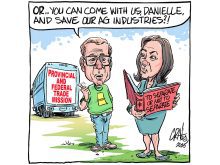There is a large and growing gap between what the government says it is doing to support agricultural research and what researchers on the front line see happening.
The federal government insists it is deeply committed to research.
Even though core funding was cut in 1995 as a deficit-fighting measure, Ottawa brags that more money actually is available because the three-year-old Matching Investment Initiative uses limited government dollars to lure private investment into research projects.
The Lethbridge Research Centre illustrates the point. In 1995, the base budget of $16.5 million was slashed 22 percent. Programs were cancelled or transferred and staff let go.
Read Also

Worrisome drop in grain prices
Prices had been softening for most of the previous month, but heading into the Labour Day long weekend, the price drops were startling.
Since then, the base budget has edged up to 1995 levels as several research programs have been transferred in from other stations, although the cuts have not been restored. Meanwhile, the private sector puts up $1 for every two the government spends.
“There’s no doubt private funding has been increasing,” station assistant director Glenn Coulter said last week. “Our A-base budget pays our scientists, keeps the doors open and the lights on. The private money is top-up for specific projects.”
The official message from Ottawa is that this injection of outside funds is keeping the research effort as healthy as it ever was.
Yet respected researcher Rob Rennie has a starkly different view.
Rennie, once an Agriculture Canada researcher, now is vice-president of Calgary-based Agrium Inc. He remains a strong supporter of public research and sees it in decline.
“It’s disappointing to see the cutbacks that go on now in public sector research because the economic wealth and the prosperity of this country now is based on that era of very strong support for research,” he said last week.
“Now, funds are being cut and researchers are drifting down to the U.S. for better salaries. I think the public research effort is suffering.”
Researchers inside the government system tell of other frustrations.
The kind of research they can do depends on the funding they can cajole. Corporate funding in search of profitable products increasingly tilts the agenda at publicly financed research stations.
Basic long-term research takes a lower priority as scientists pursue projects that will attract industry interest and support.
And perhaps most frustrating, scientists employed for their research abilities find themselves devoting increasing amounts of their time to fund-raising. “It’s crazy,” said retired Lethbridge scientist Peter Harris, honored last winter with appointment to the Order of Canada for his lifelong work on weed control. “Toward the end, I was spending as much as one third of my time trying to raise money.”
Others inside the system talk about poor morale and unease that private companies will tie their funding to production of results they like. For Rob Rennie, these are all signs of a public research system in trouble. “We are riding on yesterday’s laurels and it is a shame.”














